Facilitation of gastric compliance and cardiovascular reaction by repeated isobaric distension of the rat stomach
- PMID: 15916627
- PMCID: PMC4370837
- DOI: 10.1111/j.1365-2982.2005.00649.x
Facilitation of gastric compliance and cardiovascular reaction by repeated isobaric distension of the rat stomach
Abstract
Gastric distension causes cardiovascular reactions and enhances gastric compliance. Here, we investigated how these responses are related to each other, whether they change upon repeated distension and which neural mechanisms are involved. Mean arterial blood pressure (MAP) in phenobarbital-anaesthetized rats was recorded from a carotid artery and gastric compliance determined with an electronic barostat. Runs of intermittent gastric distension were generated by stepwise increments (5 mmHg) of intragastric (IG) pressure. While gastric compliance peaked at IG pressures of 20 mmHg, the change in MAP (predominantly hypotension) was largest at IG pressures beyond 30 mmHg. Repeated distension enhanced the MAP response to IG pressures beyond 35 mmHg, whereas gastric compliance was facilitated primarily at IG pressures below 20 mmHg. This facilitation of gastric compliance depended on the magnitude of the preceding distension. The MAP response to distension was enhanced by nitric oxide synthase inhibition, inhibited by subdiaphragmatic vagotomy but hardly affected by coeliac ganglionectomy. The facilitation of gastric compliance was changed by vagotomy in a complex manner but left unaltered by the other interventions. These findings show that isobaric gastric distension elicits both MAP and gastric compliance responses whose characteristics, mechanisms and sensitization properties differ profoundly.
Figures
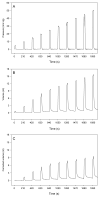
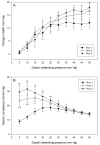
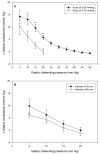
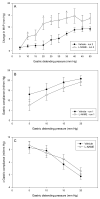
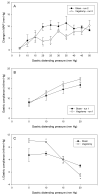
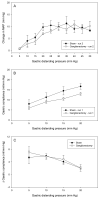
Similar articles
-
Role of capsaicin-sensitive afferent neurons in receptive relaxation induced by gastric distension in rats.Inflammopharmacology. 2007 Dec;15(6):273-7. doi: 10.1007/s10787-007-1586-0. Inflammopharmacology. 2007. PMID: 18236019
-
Characterization of vagal pathways mediating gastric accommodation reflex in rats.J Physiol. 1997 Oct 15;504 ( Pt 2)(Pt 2):479-88. doi: 10.1111/j.1469-7793.1997.479be.x. J Physiol. 1997. PMID: 9365919 Free PMC article.
-
Acid challenge delays gastric pressure adaptation, blocks gastric emptying and stimulates gastric fluid secretion in the rat.Neurogastroenterol Motil. 2003 Feb;15(1):45-55. doi: 10.1046/j.1365-2982.2003.00382.x. Neurogastroenterol Motil. 2003. PMID: 12588468
-
Modulation by endogenous nitric oxide of acid secretion induced by gastric distention in rats: enhancement by nitric oxide synthase inhibitor.J Pharmacol Exp Ther. 1999 Oct;291(1):181-7. J Pharmacol Exp Ther. 1999. PMID: 10490902
-
Responses of rat postganglionic sympathetic vasoconstrictor neurons following blockade of nitric oxide synthesis in vivo.Neuroscience. 1997 Apr;77(3):899-909. doi: 10.1016/s0306-4522(96)00504-0. Neuroscience. 1997. PMID: 9070761
Cited by
-
Characterisation of colonic accommodation in Wistar Kyoto rats with impaired gastric accommodation.Naunyn Schmiedebergs Arch Pharmacol. 2007 Nov;376(3):205-16. doi: 10.1007/s00210-007-0195-1. Epub 2007 Oct 2. Naunyn Schmiedebergs Arch Pharmacol. 2007. PMID: 17909748
-
Electroacupuncture Regulates TRPV1 through PAR2/PKC Pathway to Alleviate Visceral Hypersensitivity in FD Rats.Evid Based Complement Alternat Med. 2021 Nov 29;2021:1975228. doi: 10.1155/2021/1975228. eCollection 2021. Evid Based Complement Alternat Med. 2021. PMID: 34880917 Free PMC article.
-
To learn, to remember, to forget-How smart is the gut?Acta Physiol (Oxf). 2020 Jan;228(1):e13296. doi: 10.1111/apha.13296. Epub 2019 Jun 5. Acta Physiol (Oxf). 2020. PMID: 31063665 Free PMC article. Review.
-
DA-9701: A New Multi-Acting Drug for the Treatment of Functional Dyspepsia.Biomol Ther (Seoul). 2013 May 30;21(3):181-9. doi: 10.4062/biomolther.2012.096. Biomol Ther (Seoul). 2013. PMID: 24265862 Free PMC article. Review.
References
-
- Mayer EA. The physiology of gastric storage and emptying. In: Johnson LR, editor. Physiology of the Gastrointestinal Tract. 3rd edn Raven Press; New York: 1994. pp. 929–976.
-
- Tack J, Piessevaux H, Coulie B, Caenepeel P, Janssens J. Role of impaired gastric accommodation to a meal in functional dyspepsia. Gastroenterology. 1998;115:1346–1352. - PubMed
Publication types
MeSH terms
Substances
Grants and funding
LinkOut - more resources
Full Text Sources

